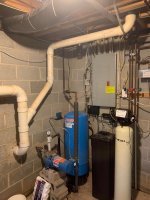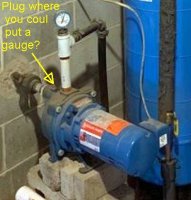A Carter
New Member
Recently, we've been having issues with water pressure from our well system. I noticed that our pump seemed to be kicking on more frequently and for shorter times than usual, so I drained our pressure tank and checked the air bladder pressure, which was low (~24 psi, while our system is set for a 40/60 cut-in/cut-off). I added air to the bladder to get it up to 38 psi, then filled the tank back up and returned service to the house. The pressure seemed to be worse at the faucets afterwards, but the pump took longer to kick on and would rn for about 1 minute before kicking off.
Fast forward to this morning - I went to take a shower, and the pressure was next to nothing. I went down to the well pump and noticed that the tank felt pretty empty and the pump still hadn't kicked on. I checked the pressure of the tank at the Schrader valve, and it was reading 38 psi, so I would think the pump should have kicked on at this point, but didn't. I bled some air from the bladder to drop the tank pressure a bit more and the pump didn't kick on until I got somewhere below 32-34 psi. Am I thinking about this wrong - If the bladder pressure is higher than the cut-in pressure, the tank pressure wouldn't get to the cut-in pressure and the pump wouldn't know to kick on, right?
I'm currently thinking one possibility is that I may have kicked up some sediment servicing the tank that gunked up our sediment filter, which would explain the decreased water pressure since I'm getting a 60 psi reading with a full tank, but I was wondering if the pump switch could be a factor as well? I'm thinking of connecting my digital pressure gauge to the Schrader valve on my pump tank and watching what the pressure does as the tank empties and the pump kicks on to see where it is cutting on and off and then adjusting the switch to get it back to 40/60 (not sure how it got changed, but maybe it happened?).
Thanks in advance!
Fast forward to this morning - I went to take a shower, and the pressure was next to nothing. I went down to the well pump and noticed that the tank felt pretty empty and the pump still hadn't kicked on. I checked the pressure of the tank at the Schrader valve, and it was reading 38 psi, so I would think the pump should have kicked on at this point, but didn't. I bled some air from the bladder to drop the tank pressure a bit more and the pump didn't kick on until I got somewhere below 32-34 psi. Am I thinking about this wrong - If the bladder pressure is higher than the cut-in pressure, the tank pressure wouldn't get to the cut-in pressure and the pump wouldn't know to kick on, right?
I'm currently thinking one possibility is that I may have kicked up some sediment servicing the tank that gunked up our sediment filter, which would explain the decreased water pressure since I'm getting a 60 psi reading with a full tank, but I was wondering if the pump switch could be a factor as well? I'm thinking of connecting my digital pressure gauge to the Schrader valve on my pump tank and watching what the pressure does as the tank empties and the pump kicks on to see where it is cutting on and off and then adjusting the switch to get it back to 40/60 (not sure how it got changed, but maybe it happened?).
Thanks in advance!


